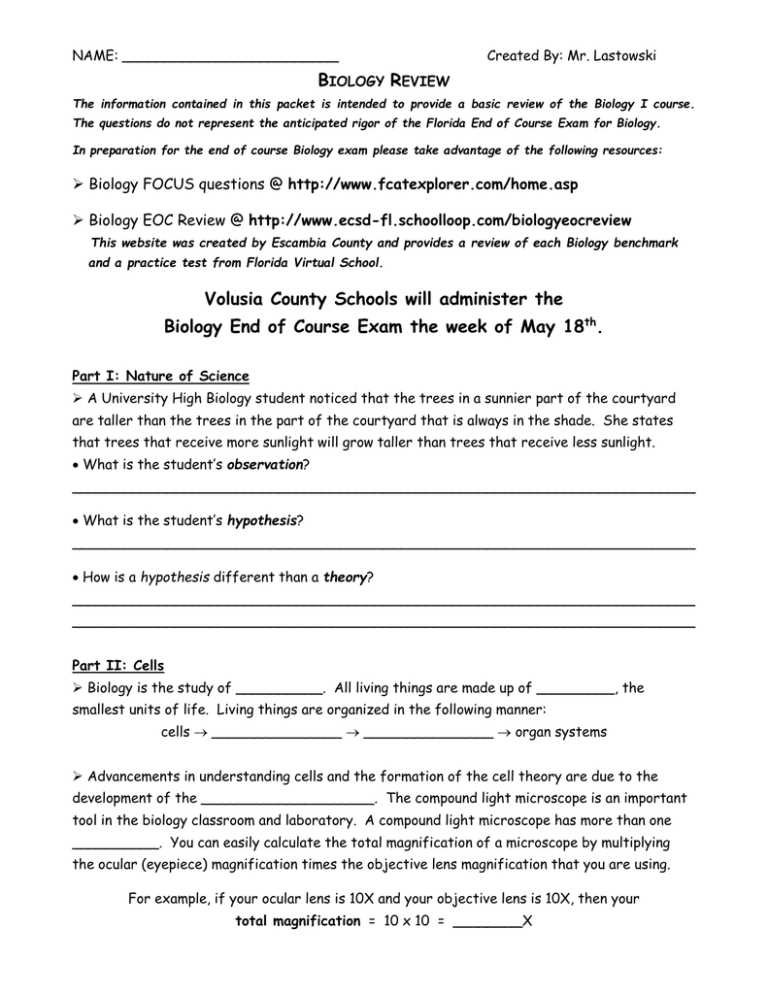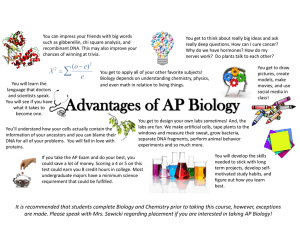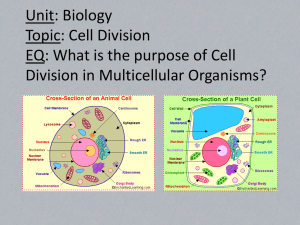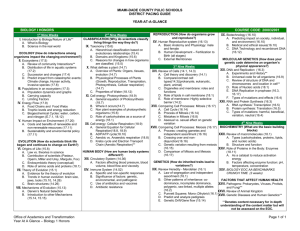EOC BIO REVIEW - University High School
advertisement

NAME: _________________________ Created By: Mr. Lastowski BIOLOGY REVIEW The information contained in this packet is intended to provide a basic review of the Biology I course. The questions do not represent the anticipated rigor of the Florida End of Course Exam for Biology. In preparation for the end of course Biology exam please take advantage of the following resources: Biology FOCUS questions @ http://www.fcatexplorer.com/home.asp Biology EOC Review @ http://www.ecsd-fl.schoolloop.com/biologyeocreview This website was created by Escambia County and provides a review of each Biology benchmark and a practice test from Florida Virtual School. Volusia County Schools will administer the Biology End of Course Exam the week of May 18th. Part I: Nature of Science A University High Biology student noticed that the trees in a sunnier part of the courtyard are taller than the trees in the part of the courtyard that is always in the shade. She states that trees that receive more sunlight will grow taller than trees that receive less sunlight. What is the student’s observation? ________________________________________________________________________ What is the student’s hypothesis? ________________________________________________________________________ How is a hypothesis different than a theory? ________________________________________________________________________ ________________________________________________________________________ Part II: Cells Biology is the study of __________. All living things are made up of _________, the smallest units of life. Living things are organized in the following manner: cells _______________ _______________ organ systems Advancements in understanding cells and the formation of the cell theory are due to the development of the ____________________. The compound light microscope is an important tool in the biology classroom and laboratory. A compound light microscope has more than one __________. You can easily calculate the total magnification of a microscope by multiplying the ocular (eyepiece) magnification times the objective lens magnification that you are using. For example, if your ocular lens is 10X and your objective lens is 10X, then your total magnification = 10 x 10 = ________X Identify and label structures 1 – 5 in the diagram below: (1) (5) (2) (3) (4) What type of cell is shown above? ____________________ ___________________ are structures inside a cell that carry out a specific function (job). Complete the table below by providing a function for the organelle listed. Organelle Cell Membrane Function Chloroplast Mitochondria Nucleus Ribosome How is a prokaryotic cell (bacteria) different from a eukaryotic cell (plant / animal)? ________________________________________________________________________ ________________________________________________________________________ How is a plant cell different from an animal cell? ________________________________________________________________________ ________________________________________________________________________ Part III: Chemistry of Life Organic compounds that are important to living things include _______________________, _________________, _________________, and ____________________ (DNA and RNA). The molecule shown below is a monosaccharide (simple sugar) known as ________________. Plants store glucose as a complex carbohydrate (sugar) called cellulose, whereas animals store glucose as a complex carbohydrate known as ____________________. _______________ include fats, oils, and waxes. They consist of long molecules like this: Proteins are made up of smaller subunits or monomers called ____________________. ____________________ are a special group of proteins involved with chemical reactions. Without enzymes, the chemical reactions in the body would happen to slow to support life. Part IV: Cell Processes _____ is a form of energy that a cell needs to perform all the tasks necessary for life. During ____________________, the energy from the sun is captured and converted into chemical energy in the form of organic compounds (glucose) in a series of linked chemical equations called a biochemical pathway. Label the REACTANTS and PRODUCTS in the following equation for photosynthesis: ____________________ ____________________ Water (H2O) is the reactant of photosynthesis that is used to produce _______________. The product glucose (C6H12O6) is a ____________________ that is produced during the Calvin Cycle of photosynthesis. The other product of photosynthesis, _________________, is necessary for the process of cellular respiration. The process of cellular ___________________ breaks down food molecules to release stored energy. Energy is released when the bond between phosphate groups in ATP is _______. When oxygen is NOT available, organic compounds such as glucose are broken down in the process of ____________________ fermentation. This process is important in the production of breads, alcohol, and cheeses. When muscles are exercised extensively in the absence of sufficient oxygen _________________________ is produced. Part V: Ecology ____________________ is the study of the interaction of living organisms with each other and their physical environment. Review the levels of ecological organization in the diagram below: Identify the difference between a population and a community. ________________________________________________________________________ ________________________________________________________________________ Define the following terms: Habitat: _____________________________________________________________ Niche: _______________________________________________________________ ____________________ describes how all organisms are linked together in a series of interactions. A diagram, like the one shown below, that shows how energy moves through an ecosystem is known as a ____________________. Organisms that make organic nutrients (sugar) for an ecosystem are called _____________. Looking at the food web above, the producer is ____________. Producers are always photosynthetic. In an aquatic or marine food web an example of a producer would be ________. The different levels in a food chain or food web are called trophic levels. The organism at the highest trophic level is said to be at the “top of the food chain.” Looking at the food web above, identify the organism at the highest trophic level: ____________________________. It is sometimes easier to view trophic levels when a food chain is organized into an ecological energy pyramid. CARNIVORE / Tertiary Consumer (4th Trophic Level) CARNIVORE / Secondary Consumer (3rd Trophic Level) HERBIVORE / Primary Consumer (2nd Trophic Level) PRODUCER (1 Trophic Level) st Only _____% of the available energy travels from one trophic level to the next. A cycling of materials is necessary for an ecosystem to survive. The Carbon Cycle, Nitrogen Cycle, and Water Cycle all involve materials required by living things that are involved in many processes that occur in living things. During the Water Cycle, water leaves the surface of the Earth and enters the atmosphere through the process of ____________________. Water returns to the surface of the Earth in the form of ____________________ (rain, sleet, snow). Humans affect the Carbon Cycle by destroying forests that absorb ___________________ and burning fossil fuels. Fossil fuels are formed from decayed plants and include coal, oil, and natural gas. Fossil fuels release ____________________ when they are burned. Part VI: Evolution and Classification The age of the Earth is estimated to be approximately ____________________ years old. Earth’s age has been estimated using ____________________ isotopes found in rocks. This technology is also used to determine the age of fossils. The atmosphere of primitive Earth was very different than it is today. Primitive Earth’s atmosphere lacked _______________ which protects the surface of the Earth from damaging ultraviolet light. _______________ is believed to be a major part of Earth’s early atmosphere. Science has offered several explanations of how life began on Earth. READ pages 368-371. Describe the scientific explanations of the origin of life on Earth. ________________________________________________________________________ ________________________________________________________________________ Most scientists have inferred that the first cells were ____________________ and ____________________. (*Remember the prefix “pro” means first) Describe how the term autotrophic is different from heterotrophic. ________________________________________________________________________ ________________________________________________________________________ Darwin was a naturalist that formed some of the earliest ideas about _________________, a theory that describes how organisms change over time. Many of his observations were from his experiences on the ____________________ Islands. On these islands he observed several species of finches that were similar in several aspects except for their beaks. Darwin believed that the different species shared a common ____________________. ____________________ describes a process by which a population becomes better suited or fit to its environment. Except for bacteria, this process may take millions of years to occur. One of Darwin’s main ideas about evolution involved natural selection. Natural selection states that organisms __________ suited to their environment ____________ and reproduce ____________ successfully than organisms less suited to the same environment. Natural selection could not occur without genetic _______________. The evidence for evolution includes comparative anatomy, embryology, genetic __________ and the ____________ record. Look at the diagram below: What type of evidence is shown, indicating that these organisms may have evolved from a common ancestor? ______________________ ____________________ describes a type of evolution that takes place when two different species become more adapted over time to each other’s presence or interaction. An example of coevolution includes pollinators (insects) and ____________________. Divergent evolution results in new species. Humans have used ________________ selection to speed up the process of divergent evolution to produce desirable traits in plants and animals. Modern humans are very different from their early hominid ancestors. One characteristic that modern humans share with their early hominid ancestors is opposable _______________. ____________________ is the science of classifying living things. Biologists classify organisms based on their _______________, _______________, and behavioral similarities. Chemical similarity includes how similar DNA is between two organisms. For example, the DNA sequences between a human and a chimpanzee would be __________ similar than the DNA sequences between a human and bacteria. The correct order of the biological hierarchy from kingdom to species is: Kingdom, Phylum, Class, Order, Family, Genus, Species You may remember this using the rhyme ________________________________________. Domains include several kingdoms. Organisms that have a nucleus belong to the domain _____ Part VII: DNA & Protein Synthesis DNA is a ____________________ that stores genetic information. DNA contains the nitrogenous bases adenine, thymine, cytosine, and guanine. Using the rule Adenine always binds with Thymine, and Cytosine always bonds with Guanine, fill in the missing letters below: DNA makes an exact copy of itself during the process of ____________________. Replication occurs during ____________________ which is the longest stage of the cell cycle. An error in DNA replication can result in genetic variations, ____________, and __________. Protein synthesis is the process where the instructions in DNA are used to make proteins. Protein synthesis has two major steps: (1) ____________________: genetic information in DNA is copied to an RNA molecule. (2) ____________________: tRNA transfers amino acids to the ribosome for assembly Part VIII: Mitosis & Meiosis _______________ is a process by which a cell’s nucleus divides. Each new nucleus is an exact copy to the original and each other. The number of chromosomes is the _________. Mitosis is involved in cell growth and repair, as well as asexual reproduction. What is the correct order for the stages of mitosis shown below? ____________________ Meiosis produces cells that have _________ the number of chromosomes. Meiosis is involved in the production of sex cells, such as sperm and egg. Sex cells therefore have half the number of chromosomes and are _______________. Meiosis involves __________________________ and ___________________________, resulting in cells that are genetically different from each other. Part IX: Genetics Mendel’s work with pea plants established the foundation for genetics. Using mathematical analysis, he developed ideas (principles) about _______________, that is how traits are passed on from one generation to the next. For example, when Mendel crossed pea plants that differed in two characteristics, he found that the inheritance of one trait _____ _____ influence the inheritance of the other trait. Punnett squares can be used to predict possible outcomes of a genetic cross. Complete the following Punnett square for two parents that are both heterozygous for brown eyes. Each parent has both a dominant gene ( B ) and a recessive gene ( b ) for eye color. Inheriting the dominant gene results in brown eyes. B b 1 2 3 4 B b What is the homozygous dominant genotype? _____ What is the homozygous recessive genotype? _____ What is the genotype in box 2 of the Punnett square? _____ Is the genotype in box 2 homozygous or heterozygous? (circle one) What percentage of the offspring is expected to have blue eyes? _____% Traits that are controlled by ____________ alleles involve several pairs of genes. In humans multiple alleles control ______________, ______________, and ______________. Genes are located on chromosomes. The X and Y chromosomes determine the sex of an individual. They are known as the ______ chromosomes. XX results in a ____________ and XY results in a ____________. The diagram shown below is called a _______________. A pedigree shows certain genetic characteristics of a family over several generations. How many males are present? _____ How many females are present? _____ How many carriers? _____ Part X: Human Body Systems Label the lobes of the brain in the diagram below: Describe the factors affecting blood flow through the cardiovascular system. ________________________________________________________________________ ________________________________________________________________________ ________________________________________________________________________ ________________________________________________________________________ Explain the basic functions of the human immune system. ________________________________________________________________________ ________________________________________________________________________ ________________________________________________________________________ ________________________________________________________________________ The body’s first line of defense against infection includes the ______, _______________, and ____________________. _______________ are useful in preventing diseases such as the flu. Vaccines trigger _______________ formation, protecting the body from pathogens. The respiratory system brings __________ into the body and removes ________________ from the body. Gas exchange happens when: Oxygen in the alveoli diffuses into the blood in the capillaries. Oxygen binds with hemoglobin in the red blood cells. The red blood cells give up oxygen to the cells of the body. The male gonads, known as the __________, are located in the scrotum. The testes produce the gamete __________ and the male hormone ____________________. The female gonads, known as the __________, are located in the abdomen of the female. Ovaries contain sex cells called eggs and produce the female hormones estrogen and progesterone. The female reproductive system also consists of the ____________, a muscular structure in which the fetus develops.







